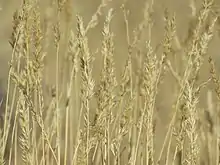Centropodia glauca
Centropodia glauca, also known as ghagras or ikagras[1][2] is a species of grass endemic to Namibia, South Africa, Kenya and Botswana. The occurrence of this grass is proof of well-preserved sandveld. The grass is very hardy and can thrive in dry veld. It is a perennial pole grass that usually grows between 200–850mm but can grow up to 1m tall. The flowering period is between September and May.[3] Because ghagras have few leaves and the stalks are almost always green, it is resistant to fire.[4]
| Centropodia glauca | |
|---|---|
 | |
| Seed pods | |
| Scientific classification | |
| Kingdom: | Plantae |
| Clade: | Tracheophytes |
| Clade: | Angiosperms |
| Clade: | Monocots |
| Clade: | Commelinids |
| Order: | Poales |
| Family: | Poaceae |
| Genus: | Centropodia |
| Species: | C. glauca |
| Binomial name | |
| Centropodia glauca (Nees) Cope | |
| Synonyms | |
| |
It grows mainly in deep sandy soil, particularly in duneveld; also grows in gravelly soil.[5] It is eaten by game, especially oryx.
It was first described by Christian Gottfried Daniel Nees von Esenbeck, and given its current name by Thomas Arthur Cope.[6]
References
- "Threatened Species Programme | SANBI Red List of South African Plants". redlist.sanbi.org.
- "Centropodia glauca (KNDGL)[Overview]| EPPO Global Database". gd.eppo.int.
- "Savanna". Spesie portefeulje vir Suid Afrika biome.
- van der Walt, Pieter; le Riche, Elias (1999). Die Kalahari en sy plante. Pretoria: Pretoria. pp. 90–91. ISBN 0-620-23415-6.
- van Oudtshoorn, Frits (1992). Guide to Grasses of Southern Africa. Pretoria: Briza publications. p. 100. ISBN 978-1-920217-35-8.
- Cope, 1983 In: Kew Bull. 37: 658
| Wikimedia Commons has media related to Centropodia glauca. |
| Wikispecies has information related to Centropodia glauca. |